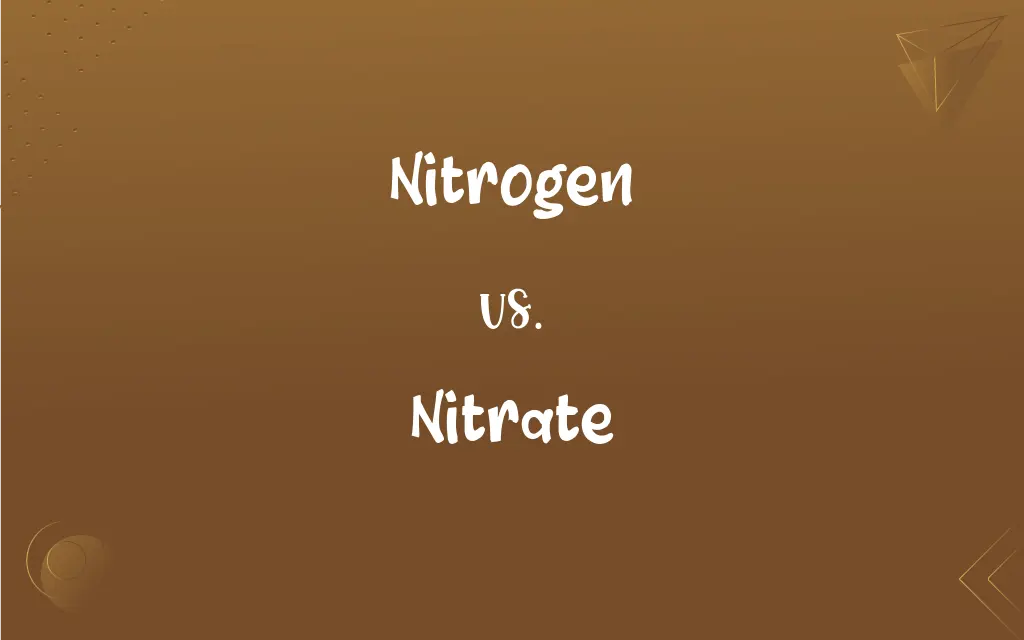Nitrogen vs. Nitrate: What's the Difference?
Edited by Aimie Carlson || By Harlon Moss || Published on December 6, 2023
Nitrogen is a chemical element (N), essential for life, while nitrate (NO₃⁻) is a compound of nitrogen and oxygen, commonly found in fertilizers.

Key Differences
Nitrogen is a colorless, odorless gas that makes up about 78% of the Earth's atmosphere. It is a fundamental element for life, integral to DNA and proteins. Nitrate, on the other hand, is a chemical compound consisting of nitrogen and oxygen, typically used in agriculture as a nutrient for plants.
In its elemental form, nitrogen is a stable, non-reactive gas, essential for the air we breathe. Nitrate, however, is a reactive ion, often found in soil and water, where it acts as a key nutrient for plant growth and development.
Nitrogen is vital for the creation of amino acids, the building blocks of proteins in all living organisms. Nitrates are primarily known for their role in fertilizers, helping to boost crop yield by providing essential nutrients.
The nitrogen cycle in nature involves the conversion of nitrogen into various chemical forms, including nitrates. Nitrate compounds, due to their solubility in water, are easily absorbed by plants, facilitating their growth.
Excessive amounts of nitrogen in the atmosphere can be harmful, leading to pollution and health issues. Excessive nitrate levels, especially in water bodies, can lead to environmental problems like eutrophication, affecting aquatic life.
ADVERTISEMENT
Comparison Chart
Chemical Form
Elemental gas (N)
Compound ion (NO₃⁻)
Role in the Environment
Part of air composition, crucial for life
Nutrient for plants, used in fertilizers
Natural Occurrence
Abundant in the atmosphere
Found in soil and water
Use in Agriculture
Converted to usable forms for plant nutrition
Directly used as a nutrient in fertilizers
Environmental Impact
Excess can cause pollution
High levels can lead to eutrophication
ADVERTISEMENT
Nitrogen and Nitrate Definitions
Nitrogen
Nitrogen is a colorless, odorless gas that is essential for life.
Nitrogen fixation by certain bacteria is crucial for plant growth.
Nitrate
Nitrate is a compound of nitrogen and oxygen, with the formula NO₃⁻.
Nitrate is commonly used in agricultural fertilizers.
Nitrogen
Nitrogen is a key component of amino acids, proteins, and DNA.
The nitrogen in amino acids helps build the proteins in our bodies.
Nitrate
Excessive nitrate can lead to environmental issues like eutrophication.
Overuse of nitrate fertilizers has led to eutrophication in nearby lakes.
Nitrogen
In its gaseous form, nitrogen is inert and non-reactive.
The stability of nitrogen gas makes it ideal for industrial applications.
Nitrate
It's a key nutrient for plants, aiding in growth and development.
The high nitrate content in soil helps in the rapid growth of vegetables.
Nitrogen
It's a chemical element with the symbol N and atomic number 7.
Nitrogen is one of the most abundant elements in the Earth's atmosphere.
Nitrate
Nitrate is soluble in water, making it easily accessible to plants.
Nitrate from fertilizers dissolves in water and is absorbed by plant roots.
Nitrogen
Nitrogen undergoes a cycle in nature, converting into various compounds.
Nitrogen in the atmosphere is transformed into usable forms by plants and bacteria.
Nitrate
Nitrates are a form of nitrogen accessible to plants.
Nitrate levels in soil are crucial for assessing soil fertility.
Nitrogen
A nonmetallic element that constitutes nearly four-fifths of the air by volume, occurring as a colorless, odorless, almost inert diatomic gas, N2, in various minerals and in all proteins and used in a wide variety of applications, including manufacture of ammonia, nitric acid, TNT, and fertilizers, and as a cryogen. Atomic number 7; atomic weight 14.0067; melting point -210.00°C; boiling point -195.80°C; valence 2, 3, 4, 5. See Periodic Table.
Nitrate
The univalent anionic group NO3, derived from nitric acid, or a compound containing this group.
Nitrogen
(uncountable) The chemical element (symbol N) with an atomic number of 7 and atomic weight of 14.0067. It is a colorless and odorless gas. Category:en:Nitrogen
Nitrate
Fertilizer consisting of sodium nitrate, potassium nitrate, or ammonium nitrate.
Nitrate
To treat with nitric acid or a nitrate, usually to change (an organic compound) into a nitrate.
Nitrate
(chemistry) Any salt or ester of nitric acid. Category:en:Nitrogen
Nitrate
To treat, or react, with nitric acid or a nitrate
Nitrate
A salt of nitric acid.
Nitrate
Any compound containing the nitrate group (such as a salt or ester of nitric acid)
Nitrate
Treat with nitric acid, so as to change an organic compound into a nitrate;
Nitroglycerin is obtained by nitrating glycerol
FAQs
Why are nitrates important in agriculture?
Nitrates are important as they provide essential nutrients that enhance plant growth.
What is nitrate?
Nitrate is a chemical compound made of nitrogen and oxygen, used primarily as a nutrient in fertilizers.
What is nitrogen?
Nitrogen is a chemical element, symbol N, essential for life, and a major component of the Earth's atmosphere.
Is nitrogen directly usable by plants?
No, nitrogen in its gaseous form is not directly usable by plants; it must be converted into nitrates or other compounds.
What happens with too much nitrate in water bodies?
Excessive nitrate in water can cause eutrophication, harming aquatic ecosystems.
How do nitrates affect human health?
High levels of nitrates can be harmful to human health, especially in drinking water.
How does nitrogen differ from nitrate in the environment?
Nitrogen is a gas in the atmosphere, while nitrate is a soluble ion in soil and water.
What forms of nitrogen do plants absorb?
Plants mainly absorb nitrogen in the form of nitrates and ammonium.
Can excess nitrogen be harmful?
Yes, excess nitrogen can lead to pollution and environmental imbalance.
What role does nitrogen play in the ecosystem?
Nitrogen is crucial for the growth of all living organisms and is a key part of the ecosystem.
Can nitrogen fixation occur naturally?
Yes, nitrogen fixation occurs naturally through certain bacteria and lightning.
How is atmospheric nitrogen converted to nitrate?
Atmospheric nitrogen is converted to nitrate through natural processes like lightning and microbial action in soil.
Do all plants need nitrate?
Most plants need nitrate for growth, though some can use other forms of nitrogen.
How do farmers manage nitrate levels in soil?
Farmers manage nitrate levels through crop rotation, appropriate fertilizer use, and soil testing.
Is nitrogen part of the human body?
Yes, nitrogen is a key element in amino acids, proteins, and DNA in the human body.
Why is nitrate monitoring important in agriculture?
Monitoring nitrate levels is crucial for ensuring soil health and preventing over-fertilization.
How are nitrates removed from water?
Nitrates are removed from water through treatment processes like ion exchange, reverse osmosis, and biological denitrification.
What is the nitrogen cycle?
The nitrogen cycle is the process by which nitrogen is converted into various chemical forms, including nitrates, as it circulates in the environment.
Are nitrates found only in fertilizers?
No, nitrates are naturally occurring but are also commonly added to fertilizers.
Is nitrogen harmful to breathe?
No, nitrogen gas is non-toxic and makes up a major part of the air we breathe.
About Author
Written by
Harlon MossHarlon is a seasoned quality moderator and accomplished content writer for Difference Wiki. An alumnus of the prestigious University of California, he earned his degree in Computer Science. Leveraging his academic background, Harlon brings a meticulous and informed perspective to his work, ensuring content accuracy and excellence.
Edited by
Aimie CarlsonAimie Carlson, holding a master's degree in English literature, is a fervent English language enthusiast. She lends her writing talents to Difference Wiki, a prominent website that specializes in comparisons, offering readers insightful analyses that both captivate and inform.































































